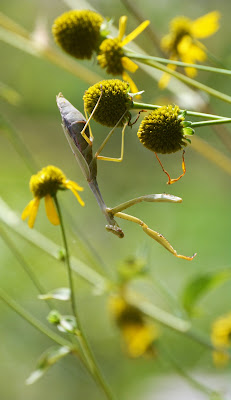Rudbeckia laciniata
Commonly called cutleaf coneflower, this member of the aster family is a fabulous fall bloomer. I love it for all the pollinators it attracts; bees, wasps, and butterflies. Take a look who is dangling from the flower heads! More on this at the end of the post.
Rudbeckia laciniate is a tall plant, growing to heights of 8' or more. In our garden it usually stays around 5' to 6' probably because it isn't in the moist condition it prefers to grow in. We planted several clumps in various areas of our garden for end of summer color and to provide late season pollinators food. The flower is a globular cone surrounded by drooping yellow rays.
Various wasps gather on the flower heads, sticking their proboscis into the tubes to find nectar.
Here's a closer look.
Blue-winged wasps are another frequent visitor. A non-native wasp, but beneficial in the garden, as it is a natural predator of the Japanese beetle. The female wasp will dig up the beetle grub, sting it to paralyze it and then place it in a hole with a fertilized egg. When the wasp larva hatches, it will eat the grub.
The blue-winged wasps have fuzzier bodies than most wasps and do grab some pollen as they move from one flower to another.
As the rudbeckia laciniate are rather lanky, they are also prime real estate for other insects such as spiders, who like to set up their webs in pollinator traffic areas. Or praying mantis who skulk around looking for an easy meal
or this love session.
This is a great native to consider for your garden. Deer don't like it. And it is a good choice for a rain garden, pocket meadow or perennial garden. Plant with Eupatorium perfoliatum or lobelia cardinalis for more impact.
I'm joining Clay and Limestone for the monthly Wildflower Wednesday celebration. See what others are sharing here.







.png)
